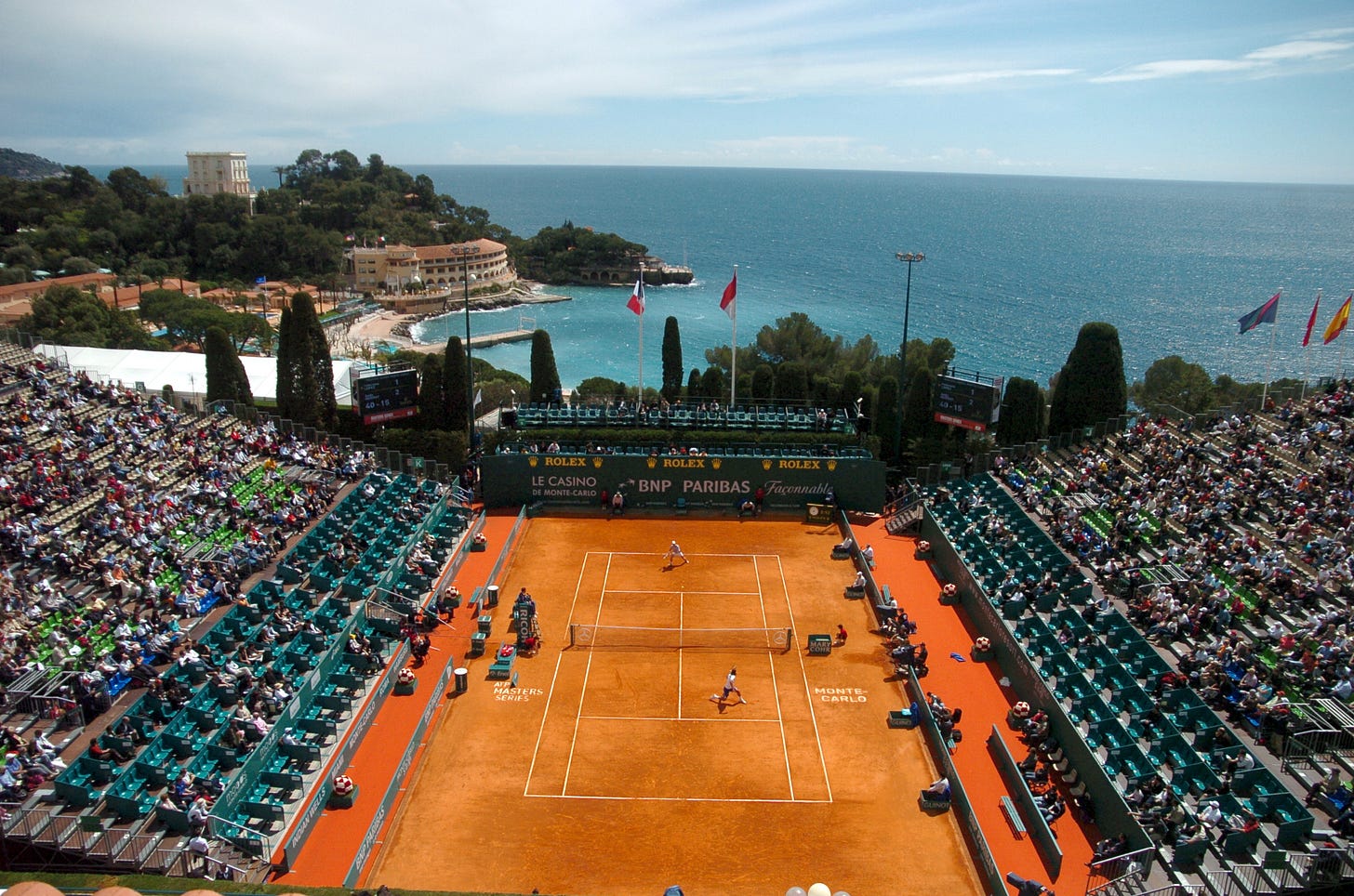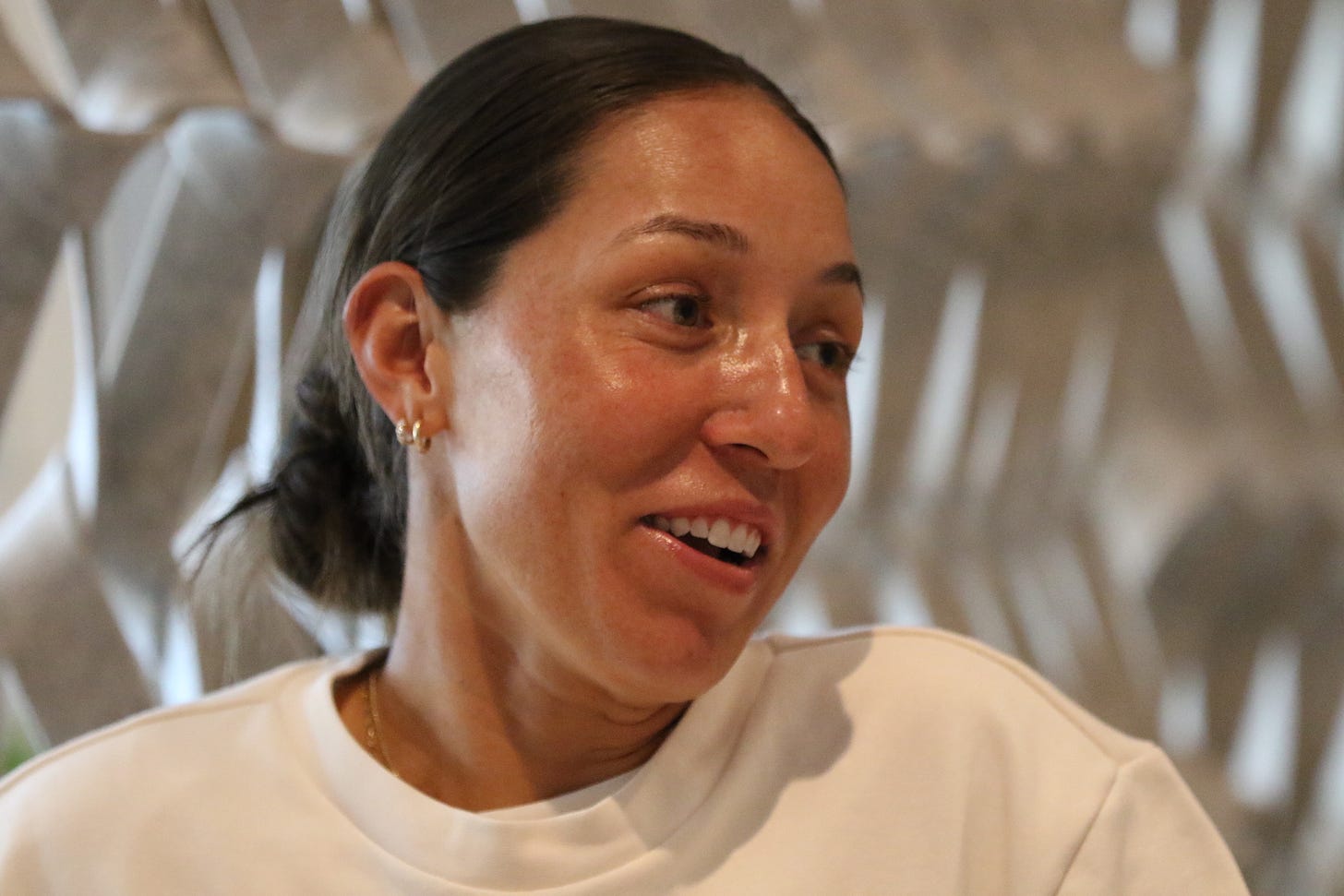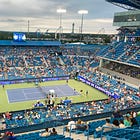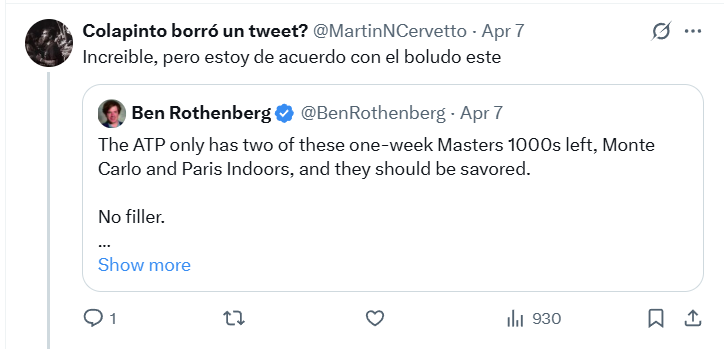One-Week Wonder
As other Masters 1000 events bloat, Monte Carlo sparkles anew as a suddenly rare gem.

I’ve been enjoying watching the early rounds from Monte Carlo this week more than I ever have in previous years, and I know why: brevity is the soul of an ATP tournament, and I’m cherishing it where I still can.
Befitting its geography and high-priced real estate, the Mediterranean tournament feels both breezy and compact. With six rounds of main draw play packed into just seven days, there were great matches on the schedule in Monte Carlo from the very first day, all played with a purposeful propulsion since the finish line was in sight.
The first day in Monte Carlo started with a bang: a wild Russian roller-coaster match between 11th-ranked Daniil Medvedev and 25th-ranked Karen Khachanov. At most other Masters 1000 events now, a match between two players of those rankings wouldn’t happen until the fifth day of main draw play, at the earliest. But in Monte Carlo, where only eight players get first round byes, marquee matches can happen immediately.
The richness of Monte Carlo has been a reminder of how much the product is getting diluted elsewhere. When Masters 1000 draws expand from 56 players to 96 elsewhere, it only adds quantity at the sake of quality, with more matches featuring less compelling players. It’s also a form of shrinkflation for ticket holders, who get fewer matches per session as the tournaments grow from seven days to 12.
This is a recent problem of the ATP’s creation, and the balance has shifted drastically since the pandemic. Back in 2019, only 2-of-9 ATP Masters 1000 events extended beyond one week in 2019: Indian Wells and Miami. But in 2025, with the footprints of Canada and Cincinnati set to extend to join the trend this summer, now 7-of-9 will.
This is subjective, but rather than making the growing tournaments feel more important, I think it’s only dragged down the relative prestige of former category standouts Indian Wells and Miami. It’s been a net-negative for the Masters 1000 brand, I think, not to mention the squeeze smaller tournaments are feeling as the Masters 1000s manspread across the calendar.
The two Masters 1000 events that have remained as one week events are, coincidentally, the two events played in France1: the autumnal Paris Indoors, and this week’s Monte Carlo Masters.
Monte Carlo, too far removed from the French Open to be a predictor there and with less reliable attendance from top stars, had always been one of the least compelling Masters events to me previously, but now it’s a breath of fresh seaside air.
When I posted a similar sentiment earlier this week, social media reactions showed widespread agreement among fans and media.
Players Prefer Shorter, Too
ATP players, too, prefer the shorter format, as I confirmed when discussing the trend during the ultra-compact Mexican Open earlier this year, a 500-level event that finishes five rounds in just six night sessions.
When I asked him his preference in Acapulco, Holger Rune told me he thinks “99 percent of players prefer the shorter tournaments.”
“I also do,” Rune added. “I think it's way better for the players. I think it's more fun for the fans. I think it's more interesting, in a way, because it's very intense. The majority of the players, we're now physically so strong that we can handle not having a day of rest every time we play a best-of-three set match…quarters, semis, finals on Friday, Saturday, Sunday, it's like, really good, actually.”
Rune recalled his run to the final of the 2023 Italian Open, the first time that tournament had extended beyond a week.
“I played Novak [Djokovic in the quarterfinals] pretty early in the day, and then I had two days off after that,” Rune said. “And then I played the semifinal, and then I had another day off. And that's a lot of days off, you know? I think it's good in Grand Slams because you need it, but for best-of-three sets, I don't see the point that much.”
Belgian veteran David Goffin, who has played 73 times in the main draw of a Masters 1000, similarly recalled when I asked him about the topic in Acapulco how interminable his 13th run to the quarterfinals of a Masters 1000 felt last October in the newly-expanded Shanghai schedule.
“Always a day off,” Goffin said. “It felt like I was there forever, only for quarterfinals—even if it was an amazing tournament. So, not a big fan of two-week tournaments.”
Marcos Giron, who doesn’t make as many deep runs at Masters 1000 events as the previous two players, also told me in Acapulco that he enjoyed the shorter format more, in part because it allowed for more dexterity in his scheduling.
“I like the two-week events, but it also just takes so much time,” Giron said. “I think the tour is so jam-packed that now it's harder to have more time at home.”
In an interview with Tennis Channel this week in Monte Carlo, Giron further explained how he wants to be able to travel home to the U.S. at some point during the clay court swing to break up the long trip, but the two-week schedules in Madrid and Rome have made any planning in advance difficult.
It’s Not Just the Men
The bloat has also hit women’s tennis: 7 of the 10 events at the WTA 1000 level now extend beyond a week, with only Doha, Dubai, and Wuhan wrapping things up within a week.
Jessica Pegula, who managed to make the final across two weeks in Miami before winning the one-week WTA 500 event in Charleston last week, told me before her first match in Charleston that she’s not a fan of the longer formats.

“I don't like the two-week tournaments; it's just so long,” Pegula said. “I mean, Grand Slams feel long, you know? And then all of a sudden, it's like, Wow, now we have all these Grand Slam-kind-of-feels throughout the year. And it can be really, really draining mentally. It's kind of like Groundhog Day, over and over again.”
Pegula, a longtime member of the WTA Player Council, said she had heard similar sentiments from her constituents.
“At least from what I've gathered from players, the majority don't love the two weeks,” Pegula said, citing complaints similar to Giron’s. “Especially if you lose early and you're stuck—I think that's the worst part. Of course, if you're winning, you don't really care as much. But OK, you lose early, maybe in the first week, and then all of a sudden you're in Europe for ten days and you think, ‘What do I do for ten days? I can't really go home.’ And then it just creates a lot of anxiety. You're stressed, you're paying extra for coaches and whoever's on your team. And so yeah, I'm just not a fan.”
I trust Pegula’s polling, though I should say that the set of WTA players I asked in Charleston last week were less unanimous than the men in their preferences.
American veteran Danielle Collins told me she thought the preference between one-week vs two-week events could come down to age.
“I think once you get to a certain age, you're kind of like, Whew, it's nice to have a day off now and then in between these matches,” Collins, who has struggled with multiple health issues, told me. “I think for the people over-30, they're probably like, this [day off] is amazing. And then maybe for the younger people, they want to just play as many matches as they can. So I'm definitely, you know, 31, and loving having those extra days between the matches at these tournaments.
“But I think the week-long events are special, too; you can kind of get more matches back-to-back, and momentum,” Collins added. “But to do that every single week would would definitely be hard, physically and mentally.”
At least one young player said she preferred longer events, though: 22-year-old Zheng Qinwen, who can excel on either rhythm: she won an Olympic gold medal in just a week, and also reached the Australian Open final last year across two weeks.
“For me I like more the two-week events,” Zheng said. “Because [after] every match, you've got a break in between.”
For more thoughts from various players on various topics in Charleston last week, I’m going to publish a notebook column tomorrow for paying Bounces subscribers-only, so if you’re interested in hearing more about topics ranging from Ajla Tomljanovic’s thoughts on why Netflix’s Break Point failed to Amanda Anisimova’s regrets over how she handled her Miami beef with Mirra Andreeva, please do subscribe to Bounces! Thanks for reading! -Ben
Oui, even though the tournament is billed as being played in Monte Carlo, Monaco, the Monte Carlo Masters is actually held just over the international border in nearby Roquebrune-Cap-Martin, France.








Quite the Argentine endorsement you got there. I’d frame that.
One-week Masters 1000 were so good. No dead time, big matches only. I understand the (money) logic behind the expanded format, but we really lost something on the way here.